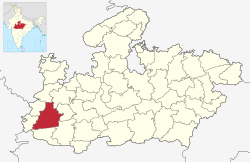Dhar district, India
Dhar district | |
|---|---|
 Jahaz Mahal at Mandu | |
 Location of Dhar district in Madhya Pradesh | |
| Country | |
| State | Madhya Pradesh |
| Division | Indore |
| Headquarters | Dhar |
| Government | |
| • Lok Sabha constituencies | Dhar |
| • Vidhan Sabha constituencies | Sardarpur (196) Gandhwani (197) Kukshi (198) Manawar (199) Dharampuri (200) Dhar (201) Badnawar (202) |
| Area | |
| • Total | 8,153 km2 (3,148 sq mi) |
| Population (2011) | |
| • Total | 2,185,793 |
| • Density | 270/km2 (690/sq mi) |
| Demographics | |
| • Literacy | 60.57 per cent |
| • Sex ratio | 961 |
| Time zone | UTC+05:30 (IST) |
| Website | dhar |
Dhar district is a district of Madhya Pradesh state in central India. The historic town of Dhar is administrative headquarters of the district.
The district has an area 8,153 km2. It is bounded by the districts of Ratlam to the north, Ujjain to the northeast, Indore to the east, Khargone (West Nimar) to the southeast, Barwani to the south, Jhabua and Alirajpur to the west. It is part of the Indore Division of Madhya Pradesh. The population of the district is 2,185,793 (2011 census), an increase of 25.60% from its 2001 population of 1,740,329. Pithampur is a large industrial area comes under Dhar District. Kukshi is the largest tehsil of the district.
Geography[edit]
The Vindhya Range runs east and west through the district. The northern part of the district lies on the Malwa plateau. The northwestern portion of the district lies in the watershed of the Mahi River and its tributaries, while the northeastern part of the district lies in the watershed of the Chambal River, which drains into the Ganges via the Yamuna River. The portion of the district south of the ridge of the Vindhyas lies in the watershed of the Narmada River, which forms the southern boundary of the district.
Divisions[edit]
Dhar district is divided into 5 sub-divisions: Dhar, Sardarpur, Badnawar, Manawar and Kukshi. These sub-divisions are further divided into 7 tehsils: Dhar, Badnawar, Dharampuri, Sardarpur, Manawar, Kukshi and Gandhwani.
There are seven Vidhan Sabha constituencies in this district: Sardarpur, Gandhwani, Kukshi, Manawar, Dharampuri, Dhar and Badnawar. All of these are part of the only Lok Sabha constituency in this district : Dhar Lok Sabha Constituency.
Demographics[edit]
According to the 2011 census Dhar District has a population of 2,185,793,[1] roughly equal to the nation of Latvia[2] or the US state of New Mexico.[3] This gives it a ranking of 208th in India (out of a total of 640).[1] The district has a population density of 268 inhabitants per square kilometre (690/sq mi) .[1] Its population growth rate over the decade 2001-2011 was 25.53%.[1] Dhar has a sex ratio of 961 females for every 1000 males,[1] and a literacy rate of 60.57%. Scheduled Castes and Scheduled Tribes made up 6.65% and 55.94% of the population respectively.[1]
At the time of the 2011 Census of India, 51.28% of the population in the district spoke Hindi, 15.62% Malvi, 15.29% Nimadi, 11.49% Bhili and 3.87% Bhilali as their first language.[5]
| Year | Pop. | ±% p.a. |
|---|---|---|
| 1901 | 293,103 | — |
| 1911 | 343,256 | +1.59% |
| 1921 | 393,577 | +1.38% |
| 1931 | 432,482 | +0.95% |
| 1941 | 473,721 | +0.91% |
| 1951 | 503,965 | +0.62% |
| 1961 | 643,774 | +2.48% |
| 1971 | 842,400 | +2.73% |
| 1981 | 1,057,469 | +2.30% |
| 1991 | 1,367,412 | +2.60% |
| 2001 | 1,740,329 | +2.44% |
| 2011 | 2,185,793 | +2.31% |
| source:[6] | ||
References[edit]
- ↑ 1.0 1.1 1.2 1.3 1.4 1.5 "District Census 2011". Census2011.co.in. 2011. Retrieved 30 September 2011.
- ↑ US Directorate of Intelligence. "Country Comparison:Population". Archived from the original on 27 September 2011. Retrieved 1 October 2011.
Latvia 2,204,708 July 2011 est.
- ↑ "2010 Resident Population Data". U. S. Census Bureau. Archived from the original on 19 October 2013. Retrieved 2011-09-30.
New Mexico - 2,059,179
- ↑ "C-16 Population By Religion - Madhya Pradesh". census.gov.in.
- ↑ 2011 Census of India, Population By Mother Tongue
- ↑ Decadal Variation In Population Since 1901